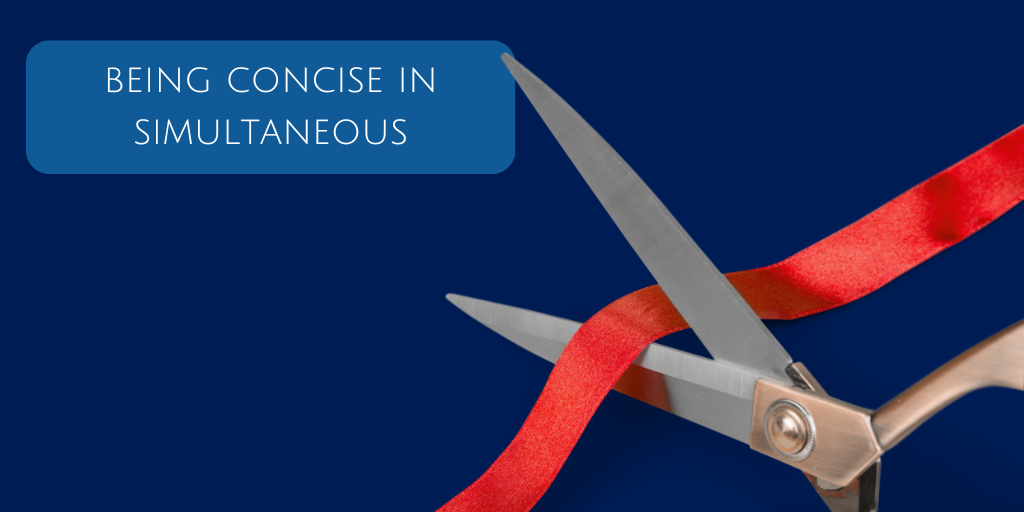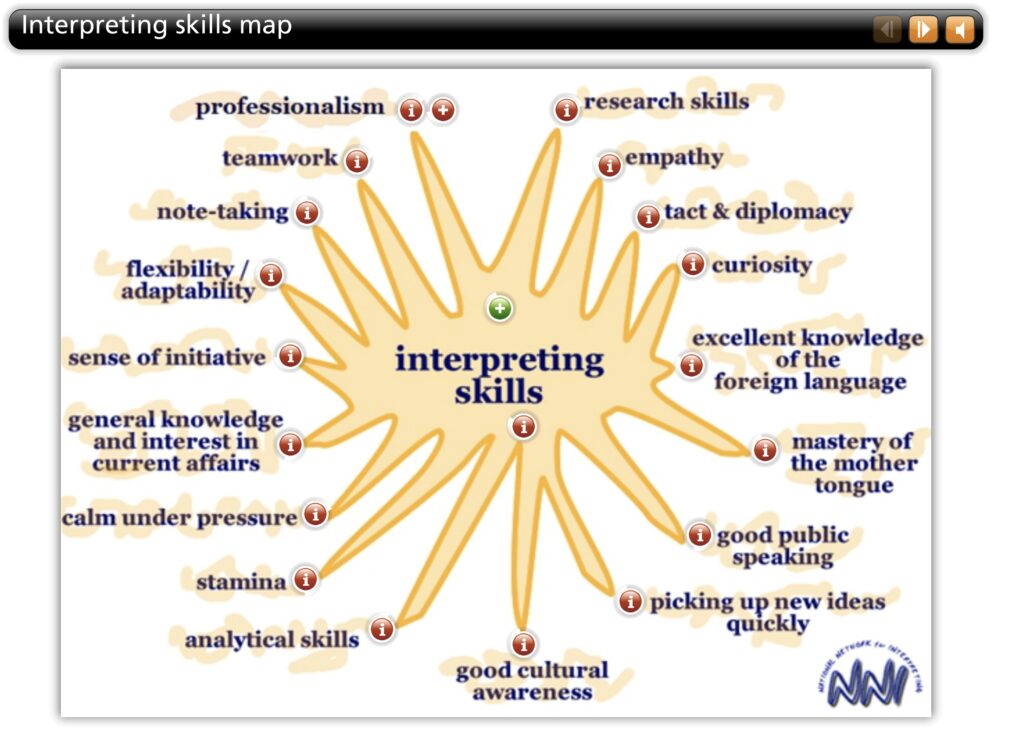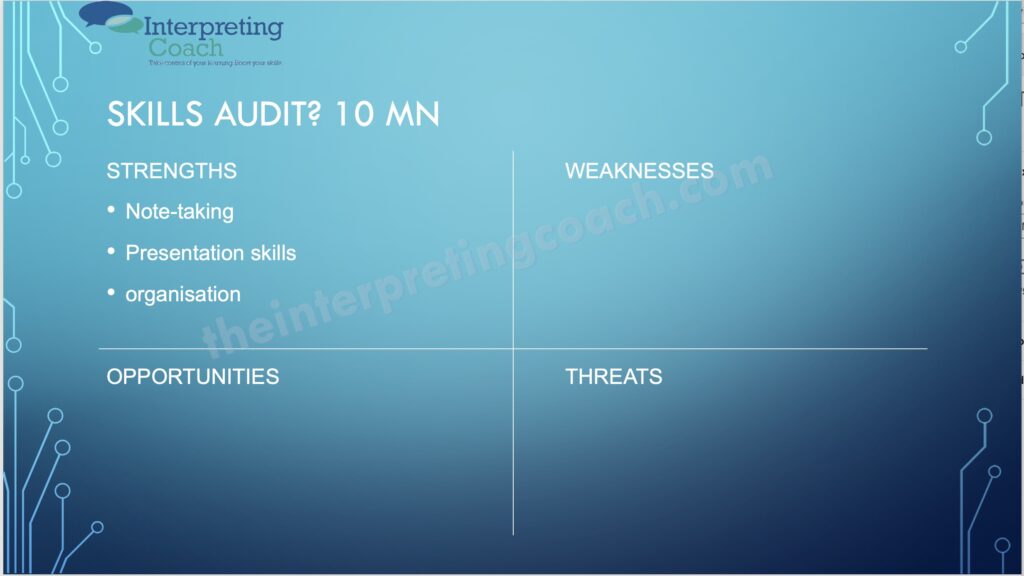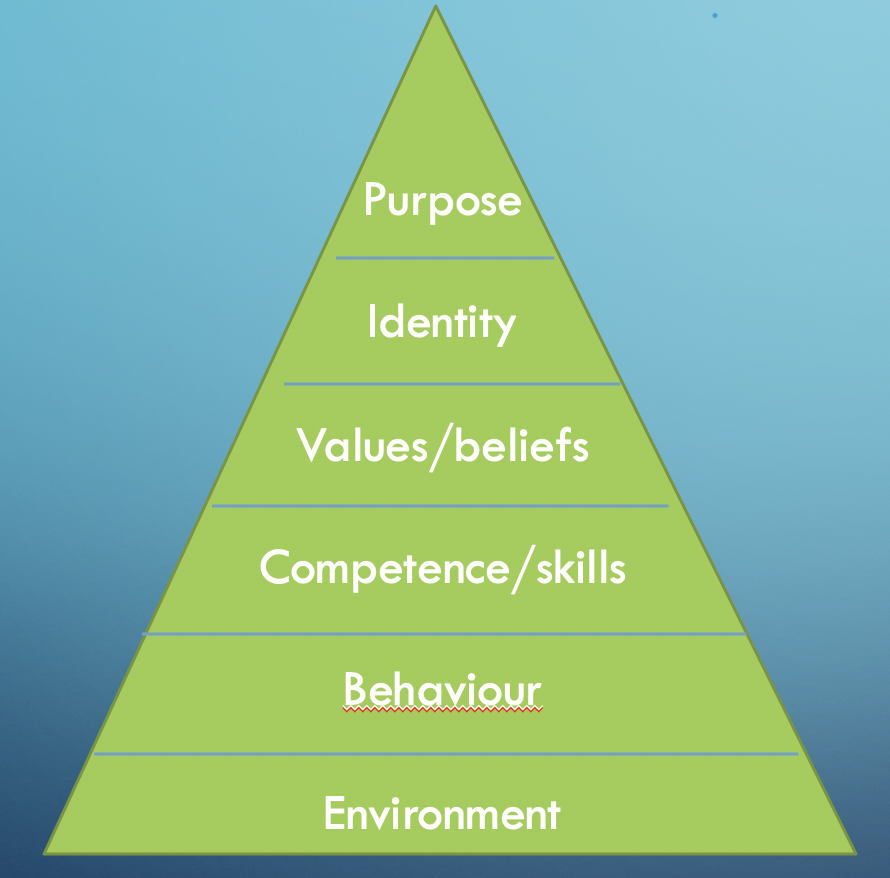I’m sure you’ve been told at some point in your career as an interpreter (or when you were a student) that you should be more concise.
Working into English, being more concise than the original is often desirable because wordy, flowery, or convoluted structures sound very strange when converted into English more or less verbatim. For example, abstract French or verbose Italian both sound very unnatural if you don’t rework the original and turn it into something more English-sounding.
So being concise can be helpful for your audience and relay takers: it sounds more natural in English, it helps prevent linguistic interference, and it’s cognitively easier to cope with. Instead of masses of words that your listeners have to retain in their working memory, they are spoon fed something shorter, clearer, and more structured, which relieves the load on their cognitive processes.
Not only is a concise version easier for the audience and relay takers, it can help the interpreter do a better job.
Why? Because if you’re uttering fewer words, you have more time to listen, and therefore more time to analyse the message. In turn, this gives you more opportunity to take decisions about what and how to edit the material. Better analysis = more faithful rendition of the message, as well as a clearer output.
Another advantage of freeing up some of your processing capacity by speaking less is that you have a little more time to reformulate, so your output (linguistically) may benefit.
A final advantage is that if you’re more concise, you’re less likely to be sitting right on your speaker’s shoulder, following very closely – in décalage* terms – because you’re trying to say everything. You’re likely to find that your décalage varies a bit more if you’re deliberately being concise, giving you more breathing space in places, and helping to avoid the kamikaze technique of interpreting, where your EVS* is so short that you hit a brick wall if you misunderstand something in the original or encounter an unknown word (i.e. you may be left with no other option than to leave a sentence unfinished, which is less than ideal!).
I’ve already said a lot about being concise, but what does it mean? Is it simply a matter of using fewer words?
The Oxford Language Dictionary defines concise thusly:
“giving a lot of information clearly and in a few words; brief but comprehensive”
This is interesting because it suggests that a) being concise isn’t just about editing out information (i.e. dropping it), but about conveying the same the information using fewer words, and b) clarity and concision go hand in hand (more on that in a separate blog post, perhaps).
Too many words
Remember this scene from the film Amadeus? Mozart wrote too many notes (according to the Emperor); sometimes interpreters are tempted to use too many words in simultaneous.
How can you prune the dead wood?
Well, there are some fairly uncontroversial approaches to reducing your word count [please bear in mind that this is written from the perspective of a conference interpreter, not a court interpreter, for example]:
- leave out hesitations (‘um’, ‘er’)
- eliminate fillers (e.g. if the speaker says ‘you know’, ‘I mean’, ‘basically’, etc.)
- cut out repetition or redundancy
- choose your words wisely; for instance, avoid unnecessarily long versions of words (like utilise instead of use, or transportation instead of transport)
- avoid redundant pairs (a terrible tragedy)
- use the active voice where possible
- don’t ‘hedge’ if the speaker isn’t doing so (e.g. with phrases like ‘it seems that’, ‘if you like’, ‘it may be the case that’. This is something that interpreters often do when they are afraid to commit, especially if the speaker has said something that sounds controversial or implausible. If you make your output more concise, you’ll have more time to listen and analyse – and be clearer about the speaker’s message! 🙂
One caveat: it’s important to distinguish between source language features that are typical of a particular language (e.g. long-winded syntax in Italian), as opposed to features that are deliberate on the speaker’s part, because he or she is aiming for a particular effect. If the verbosity is a question of style or tone, you will have to decide whether it’s important to retain those features and potentially sacrifice some other information, or vice versa.
Now, you may think I’ve reached the end of this blog post. After all, I’ve gone over a list of ways to reduce your word count.
However, in my opinion, it’s not that simple.
If you have a few spare minutes, I invite you to listen to these two clips, in which I interpret a French speech about hydrogen from the SCIC Speech Repository in simultaneous. [Please note I did zero preparation for this, so I can’t claim to have been firing on all cylinders when it came to technical vocabulary.]
If you have French in your combination, please have a go at interpreting the first 2 or 3 minutes yourself, before listening to my version.
Can you hear the difference between these two versions? Does one of them sound clearer and more concise to you? Does one of them sound more rushed, and less natural in English?
In one of these clips, I tried to stick as closely to the speaker as possible, and to say everything, more or less in the same way that she had.
The other version is closer to my natural style. I devoted more effort to analysis and editing.
You may of course disagree with my opinion, but for me, the more concise version sounds calmer, more in control, and clearer.
I typed out a transcript of these two versions, and discovered, somewhat to my surprise, that the ‘short’ version was only 62 words shorter than the ‘long’ version, which didn’t seem like a lot over a period of 2 1/2 minutes.
Perception is important
I’m going to use this example to argue that being concise isn’t just a matter of using fewer words.
It’s also a matter of the ‘digestibility’ of your output for the audience and relay takers, i.e. it’s about their perception of whether you are being concise. 😉
Here are some of the tricks I used in the audio clip to sound more concise:
- Use ‘salami technique’, also known as ‘chunking’, to chop the source material into shorter pieces.
- If the target language allows, use SVO word order (subject-verb-object).
- Start the sentence with the subject, rather than with long adverbial phrases, so the audience immediately knows what you’re talking about.
- Keep the subject close to the verb, thus avoiding conjugation errors, and reducing the load on everyone’s working memory (this includes yours!).
- Make sure the links between ideas are clear, using logical connectors such as and, but, so, if.
- Use active voice where possible.
- Use intonation as a fantastic shortcut. Intonation is great for conveying meaning. For example, you can use your voice to show whether something is an important point, a digression, a question, a humorous interjection, etc. (show rather than telling!).
A similar caveat to the one I made earlier: if the speaker is using long and complicated sentences, passive voice, etc., you need to give some thought to why they are doing this. Is it just their normal way of speaking? Or are they doing this to try to sound intelligent or knowledgeable, or to sound more scientific and therefore more credible? Remember that as an interpreter, part of your job is to have the same effect on the audience as the speaker was aiming for. If the speaker is using long-winded platitudes for a reason, you’ll need to decide whether to do the same, or whether you can achieve the same effect in the target language while still remaining concise.
Conclusion
Being concise isn’t always desirable, I suppose. Alongside some of the reasons I’ve mentioned above (style, tone, the effect the speaker is aiming for), there’s also the fact that your target language may be one that values flowery and lengthy sentences as a sign of intelligence and erudition.
In English, though, I would argue that being concise and using salami technique won’t, as some interpreters fear, make them sound childish. The trick is to use simple syntax, but appropriate vocabulary – which may mean sophisticated, high register, or technical vocabulary.
I hope to have persuaded you in this blog post that being concise isn’t as simple as using fewer words.
Instead, it’s a lot to do with making shorter chunks, joining them up with clear links, inserting pauses in the right place, and shaping the chunks with intonation so the meaning is clear.
*décalage = Ear/Voice Span = the time lag between the original speaker’s words and the interpreters’ rendition.
Transcripts
For anyone who’s interested, here are the transcripts of my two attempts at the hydrogen speech.
Version 1 (366 words):
Ladies and Gentlemen, now that the end of the pandemic is almost here, we can go back to taking an interest in those subjects that were fascinating for us before the beginning of the pandemic, namely climate change and the environment, and that was the challenge that we needed to take up before the beginning of this crisis, and it is therefore essential that we return to taking an interest in this subject. There is some good news connected to our interest in the environment, and I know we’re all keen on hearing good news. For 2020, the share of renewables in energy production in Europe has now exceeded fossil fuels, and that is the case for the second year running, because it was already that way in 2019. Now solar power is cheaper than anywhere else in the world, and its production has increased by 20 % in Europe. And finally, the price of carbon has increased exponentially. So much for the good news, but I know that you’re not naïve, and I know that you are aware that we are a long way from having achieved any significant change or reached our environmental objectives. Today, I’m going to talk about an element which is a sign of hope for some, an element that will allow us to reach our objectives, and that is hydrogen. Now before going into any more interesting details, let me just recap on a bit of chemistry. Hydrogen is a basic chemical element, H, which is present in the universe and on Earth. On Earth, it is present principally in the form of water. Hydrogen is associated to the molecule O, oxygen, and together they form H2O, water. In order to produce hydrogen, you need to break the bond between hydrogen and oxygen. In order to do that, we use a process called electrolysis, where we use an electrical current in order to break the bond between the two molecules and obtain hydrogen. Now, you might ask me why we would want to produce hydrogen, and the answer is because it has a number of applications. Hydrogen can be used as a fuel, it can also be stored and transported.
Version 2 (302 words):
Ladies and Gentlemen, the end of the pandemic is in sight, soo we can go back to those topics that gripped us before coronavirus: climate change and the environment. Those were the real challenges that we were facing before the crisis, and it’s crucial that we return to taking an interest in these subjects. There is some good news when it comes to the environment, and I know that at the moment we’re all keen to hear good news. In 2020, the share of renewable energies in electricity production in Europe was greater than the share of fossil fuels, for the second year running. Solar power is cheaper in Europe than anywhere else in the world, and its production increased by 20% in Europe. And the price of carbon has increased exponentially. That’s the good news. But you’re not naïve, and I’m sure you’re very aware that we are a long way from reaching our environmental goals and making any significant changes. Today, I’m talking about an element which could help us to reach these objectives. It could be very promising. And that is hydrogen. Before I go into details, let me recap some chemistry. Hydrogen is a basic chemical element, represented by the letter H. It’s present in the universe and on Earth. On Earth, it generally takes the form of water. It is associated with the molecule O, oxygen, and that makes water, H2O. In order to produce hydrogen, you have to break the chemical bond between the two molecules. You do that through electrolysis, which is where you use an electrical current to separarate the two molecules, and obtain hydrogen. Now you might say: why produce hydrogen? Because it has a number of applications. You can use hydrogen as a fuel. You can store it, you can transport it.











